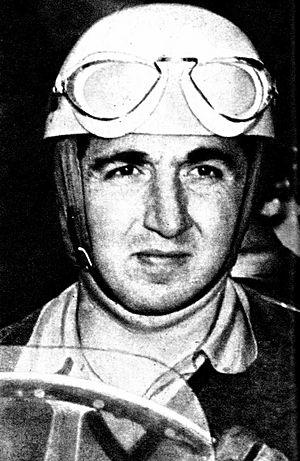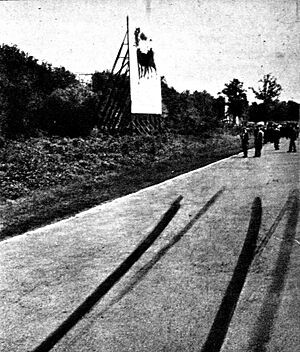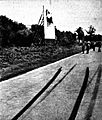Alberto Ascari facts for kids

Ascari before a test in Montecarlo
|
|||||||||
| Born | 13 July 1918 Milan, Kingdom of Italy |
||||||||
|---|---|---|---|---|---|---|---|---|---|
| Died | 26 May 1955 (aged 36) Autodromo Nazionale Monza, Italy |
||||||||
| Formula One World Championship career | |||||||||
| Nationality | |||||||||
| Active years | 1950 – 1955 | ||||||||
| Teams | Ferrari, Maserati, Lancia | ||||||||
| Entries | 33 (32 starts) | ||||||||
| Championships | 2 (1952, 1953) | ||||||||
| Wins | 13 | ||||||||
| Podiums | 17 | ||||||||
| Career points | 107 9⁄14 (140 1⁄7) | ||||||||
| Pole positions | 14 | ||||||||
| Fastest laps | 12 | ||||||||
| First entry | 1950 Monaco Grand Prix | ||||||||
| First win | 1951 German Grand Prix | ||||||||
| Last win | 1953 Swiss Grand Prix | ||||||||
| Last entry | 1955 Monaco Grand Prix | ||||||||
|
|||||||||
Alberto Ascari (born July 13, 1918 – died May 26, 1955) was a famous Italian racing driver. He became a two-time Formula One World Champion. Alberto was a very skilled racer. He started with motorcycles before moving to cars. He won two championships in a row, in 1952 and 1953, driving for Scuderia Ferrari. He was Ferrari's first World Champion. He is also the last Italian to win the Formula One title so far.
Alberto Ascari was known for his careful and precise driving. This made him one of the safest drivers in a very dangerous time for racing. Sadly, he died in an accident during a test session. His death was a tragic coincidence. It happened at the same age as his father's death, on the same day of the month, and in similar ways.
Contents
Early Life and First Races
Alberto Ascari was born in Milan, Italy. His father, Antonio Ascari, was also a well-known racing driver in the 1920s. Antonio raced for Alfa Romeo. Just before Alberto's seventh birthday, his father died in a racing accident. This happened during the 1925 French Grand Prix. Even after this tragedy, young Alberto still loved racing. He even ran away from school twice because he wanted to be a racer like his dad.
He started his racing journey on motorcycles. At just 19, Alberto joined the Bianchi team. He later began racing cars regularly in 1940. This was after he entered the famous Mille Miglia race. He drove a car given to him by his father's close friend, Enzo Ferrari. In the same year, he also got married.
During World War II, Alberto's family garage helped service Italian military vehicles. He also started a successful business. He supplied fuel to army bases in North Africa. His racing friend, Luigi Villoresi, was his business partner. Because their business helped the war effort, they did not have to join the army.
Becoming a Formula One Champion
After World War II ended, Alberto Ascari started racing in Grand Prix events. He drove a Maserati 4CLT. His teammate was Villoresi, who became a close friend and mentor. They had many successes in races across Northern Italy. People started calling him Ciccio, which means "Tubby."
In 1946, new Formula One rules were created. Alberto was a top driver during these years. He won his first Grand Prix race in 1948. It was the Gran Premio di San Remo. He also finished second at Silverstone that year.
In 1949, Alberto won another race with Maserati. Then, he and Villoresi joined Scuderia Ferrari. The team boss, Enzo Ferrari, had been a good friend of Alberto's father. Enzo was very interested in Alberto's racing success. That year, with Ferrari, Alberto won three more races.
The first official Formula One World Championship season began in 1950. Ferrari joined the championship at the Monaco Grand Prix. Alberto was part of the team. Their car was not fast enough at first. But Ferrari kept working on it. By the end of the year, Alberto finished second in the Italian Grand Prix.
In 1951, Alberto was a strong challenger. He won races at the Nürburgring and Monza. He was very close to winning the championship. But a bad tire choice in the final race meant he finished fourth. Juan Manuel Fangio won the title that year.

For the 1952 season, the World Championship used different car rules. Alberto drove Ferrari's Tipo 500 car. He missed the first race because he was at the Indianapolis 500. This race was part of the World Championship back then. He was the only European driver to race at Indy during that time. His race there ended early.
When he returned to Europe, he won all six remaining races of the season! He also set the fastest lap in each of those races. This amazing performance helped him win his first World Championship title. He earned the most points possible that year.
He continued his winning streak into the 1953 season. He won three more races in a row. This gave him nine straight championship wins. His winning streak ended when he finished fourth in France. But he still won two more races later that year. This made him a two-time World Champion. He was the first driver in Formula One history to win two titles!
Later Career and Tragic End
After 1953, Alberto left Ferrari because of a disagreement about his salary. He joined Lancia for the 1954 season. But Lancia's new car wasn't ready for most of the year. So, Alberto raced for Maserati and even Ferrari a few times. He did win the Mille Miglia race that year in a Lancia sports car. When the Lancia D50 car was finally ready, Alberto showed its speed. He started from pole position and led the race. But he had to stop early due to a problem.
His 1955 season started well. He won two non-championship races in the Lancia. He even beat the powerful Mercedes cars. But in the official championship races, he had to retire early.
At the Monaco Grand Prix on May 22, 1955, Alberto had a scary crash. He was leading the race when he missed a turn and drove into the harbor! His car sank into the sea. Luckily, he was pulled out and only had a broken nose.
Just four days later, on May 26, Alberto went to Monza. He was there to watch his friend Eugenio Castellotti test a Ferrari sports car. Alberto was not supposed to drive that day. But he decided to try a few laps. He was wearing his regular clothes and Castellotti's helmet. On his third lap, the car suddenly skidded. It flipped over twice. Alberto was thrown from the car. He suffered serious injuries and died a few minutes later. The accident happened on a fast corner called Curva del Vialone. This corner was later renamed Variante Ascari in his honor.
Many racing fans were very sad. Alberto Ascari was buried next to his father's grave in Cimitero Monumentale in Milan. His death is often seen as a reason why Lancia stopped racing in 1955. The company was also having financial problems at the time. Lancia then gave its team, drivers, and cars to Enzo Ferrari.
Legacy and Memory
Alberto Ascari is remembered as one of the greatest racers ever. A street in Rome is named after him. Also, two race tracks, Autodromo Nazionale Monza and Autodromo Oscar Alfredo Gálvez, have turns named after him. In 1992, he was added to the International Motorsports Hall of Fame. A British supercar company, Ascari Cars, is also named in his honor.
The famous Italian-American racer Mario Andretti looks up to Ascari. Mario watched him race at Monza when he was young. In 1972, one of the turns at the Monza track was officially named Variante Ascari. Alberto Ascari was also inducted into the FIA Hall of Fame in December 2017.
In a 2009 survey of Formula One drivers, Ascari was voted the sixteenth greatest F1 driver of all time. More recently, in 2020, a study ranked him as the fourth best Formula One driver ever.
Formula One Records
Alberto Ascari holds some impressive Formula One records:
- Highest percentage of wins in a season: He won 75% of the races in 1952, winning 6 out of 8 races.
- Highest percentage of fastest laps in a season: He set the fastest lap in 75% of the races in 1952, doing so in 6 out of 8 races.
- Most consecutive fastest laps: He had 7 fastest laps in a row.
- Highest percentage of possible championship points in a season: He earned 100% of the possible points in 1952.
- Most hat tricks (pole, win & fastest lap in same race) in a season: He achieved 5 hat tricks in 1952.
- Most consecutive laps in the lead: He led for 304 laps in a row between the 1952 Belgian Grand Prix and the 1952 Dutch Grand Prix.
Images for kids
See Also
 In Spanish: Alberto Ascari para niños
In Spanish: Alberto Ascari para niños
- Walk of Fame of Italian sport











